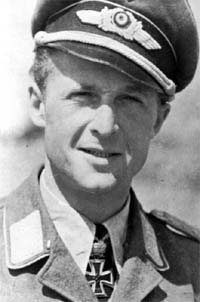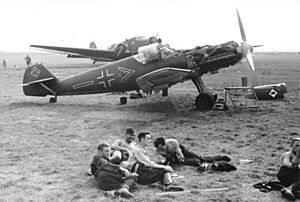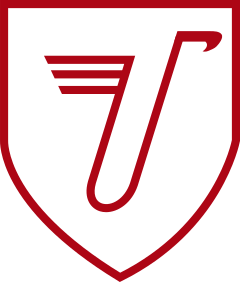Wolf-Dietrich Wilcke facts for kids
Quick facts for kids
Wolf-Dietrich Wilcke
|
|
|---|---|

Wolf-Dietrich Wilcke
|
|
| Nickname(s) | "Fürst" |
| Born | 11 March 1913 Schrimm, Kingdom of Prussia, German Empire |
| Died | 23 March 1944 (aged 31) near Schöppenstedt, Free State of Brunswick, Nazi Germany |
| Buried |
Cemetery in Mönchengladbach-Holt
|
| Allegiance | |
| Service/ |
Reichsheer (1934–35) Luftwaffe (1935–44) Condor Legion (1939) |
| Years of service | 1934–44 |
| Rank | Oberst (Colonel) |
| Unit | J/88, JG 53, JG 3 |
| Commands held | III./JG 53, JG 3 |
| Battles/wars | |
| Awards | Knight's Cross of the Iron Cross with Oak Leaves and Swords |
| Relations | Friedrich von Scotti (stepfather) |
Wolf-Dietrich Wilcke (born March 11, 1913 – died March 23, 1944) was a German pilot during World War II. He was a 'fighter ace,' meaning he shot down many enemy planes. He is credited with 162 victories in 732 combat flights. Most of his victories were on the Eastern Front, and 25 were on the Western Front. These included four large, four-engined bombers.
Wilcke was born in Schrimm, which was part of Germany then and is now in Poland. He joined the German military in 1934. At first, he was in the Army, but in 1935, he moved to the Luftwaffe (the German Air Force). After learning to fly, he joined a fighter wing called "Richthofen" in 1936. He later became a flight instructor.
In 1939, he volunteered to fight in the Spanish Civil War with the Condor Legion. After returning from Spain, he became a squadron leader for Jagdgeschwader 53 (JG 53), a fighter wing. He got his first aerial victory on November 7, 1939. During the Battle of France in May 1940, his plane was shot down, and he became a prisoner of war. After France surrendered, he was released. He then became a group commander for JG 53 during the Battle of Britain, where he shot down 10 enemy planes over England.
Wilcke later fought in Operation Barbarossa, the German invasion of the Soviet Union. After achieving 25 aerial victories, he received the Knight's Cross of the Iron Cross in August 1941. In September 1941, his group moved to the Mediterranean Theater, where he gained more victories. By August 1942, he became the commander of Jagdgeschwader 3 (JG 3) "Udet." After his 100th victory in September, he received the Knight's Cross of the Iron Cross with Oak Leaves. During the Battle of Stalingrad, he reached 150 victories in December 1942. On December 23, 1942, he was awarded the Knight's Cross of the Iron Cross with Oak Leaves and Swords for his 155 victories.
After receiving this high award, he was officially told not to fly combat missions anymore. However, he still flew sometimes. On March 23, 1944, while defending Germany, he achieved his 162nd and last victory. He was then shot down and killed by American P-51 Mustang fighters near Schöppenstedt.
Contents
Early Life and Military Career
Wilcke was born on March 11, 1913, in Schrimm. His father, a military captain, died when Wilcke was very young. In 1931, Wilcke was arrested for attending a protest by the Nazi Party, which was illegal at the time. Even though his military records said he was loyal to the Nazis, some historians believe he was against the Nazi government. For example, he once had the Swastika symbols painted over on his unit's planes.
After finishing school, he joined the German Army in 1934. His stepfather, Friedrich von Scotti, was also in the same regiment. In 1935, Wilcke transferred to the new German Air Force, the Luftwaffe. He was promoted to second lieutenant in 1936. He joined a famous fighter wing named after Manfred von Richthofen, a World War I ace. Wilcke was a very good pilot and leader, so he was sent to be a fighter pilot instructor.
In March 1939, Wilcke volunteered to serve in the Condor Legion during the Spanish Civil War. He flew missions but did not shoot down any planes there. He was given the Spanish Cross for his service. In Spain, he became friends with Werner Mölders. When Mölders became a group commander for JG 53, he chose Wilcke to lead one of his squadrons.
World War II Battles
World War II started on September 1, 1939, when Germany invaded Poland. Wilcke flew missions over Poland. His first aerial victory happened on November 7, 1939, over the Western Front. He shot down a French Potez 630 fighter near Völklingen. For this, he received the Iron Cross 2nd Class.
In March 1940, he shot down another French plane. On March 25, he claimed his third victory, a French Morane-Saulnier M.S.406 fighter.
Battle of France and Britain
The Battle of France began on May 10, 1940. On May 18, 1940, Wilcke's plane was shot down during a fight with French Curtiss P-36 Hawk fighters. He parachuted out and was taken prisoner. After France signed an armistice, he was released on June 30, 1940. He was promoted to captain and took command of his squadron again. On July 11, 1940, he received the Iron Cross 1st Class.

On August 13, 1940, during the Battle of Britain, Wilcke became the commander of the III. Group of JG 53. On the same day, he almost died when his engine failed over the English Channel. He had to parachute out and was rescued that night. On August 30, he shot down a Supermarine Spitfire near Dover. On September 1, he claimed his fifth victory, a Hawker Hurricane. He shot down two more planes on September 30, bringing his total to 12. His last victory in the Battle of Britain was on October 10, 1940, a Spitfire. For his achievements, he received the Honor Goblet of the Luftwaffe in April 1941.
Fighting on the Eastern Front
In June 1941, Wilcke's unit moved to the Eastern Front for Operation Barbarossa, the invasion of the Soviet Union. On June 22, the first day of the invasion, Wilcke shot down three Polikarpov I-15 biplane fighters. He claimed two more victories that day, becoming an "ace-in-a-day" (meaning he shot down five or more planes in one day). This brought his total victories to 18.
On June 25, Wilcke was slightly hurt when his plane crashed during takeoff. He continued to fly and achieved his 19th victory on June 30. By July 30, he had shot down a Polikarpov I-180 fighter, reaching 25 victories. For this, he received the Knight's Cross of the Iron Cross on August 6, 1941. His unit returned to Germany in October 1941.
North Africa and Malta
After returning to Germany, Wilcke's unit was sent to the Mediterranean Theater. They arrived in Sicily in November 1941. In December, they moved to Libya. Wilcke claimed his 34th victory there.
His unit then moved back to Sicily in December 1941 to fight in the siege of Malta. Malta was a very important island in the Mediterranean Sea. British forces there could attack German and Italian ships carrying supplies to North Africa. To stop this, the German and Italian air forces bombed Malta. During the siege, Wilcke shot down four British fighters in April and May 1942.
Commander of JG 3
On May 18, 1942, Wilcke was transferred to Jagdgeschwader 3 (JG 3) "Udet," another fighter wing named after a World War I ace. This unit was fighting on the Eastern Front. On August 11, Wilcke became the commander of JG 3.
Wilcke claimed his first victory with JG 3 on June 13, 1942, a Lavochkin-Gorbunov-Gudkov LaGG-3 fighter, his 39th overall. He shot down many more planes in June and July. On July 3, he claimed three Douglas Boston bombers. The next day, he shot down two LaGG-3s and another Boston. On July 6, he became an "ace-in-a-day" again, shooting down six planes. By the end of July, he had 76 victories.
In August 1942, Wilcke continued to achieve victories. On September 6, he shot down two more planes, bringing his total to 100 aerial victories. He was the 20th German pilot to reach this milestone. On September 9, 1942, he received the Knight's Cross of the Iron Cross with Oak Leaves.
Battle of Stalingrad
From September to November 1942, Wilcke led fighter operations during the Battle of Stalingrad. He was based at the Pitomnik Airfield. During this time, he claimed many more victories. On September 22, 1942, he shot down six Yakovlev Yak-1 fighters over Stalingrad, his third "ace-in-a-day" achievement. This brought his total to 116 victories.
By November 1, 1942, his personal total reached 135 victories. He received the German Cross in Gold on November 3, 1942. After the German 6th Army was surrounded at Stalingrad, Wilcke helped organize fighter escorts for planes bringing supplies to the trapped soldiers. He claimed two victories on November 24, an Ilyushin Il-2 and a Yak-1. By December 12, he had 148 victories.
On December 17, 1942, Wilcke became the fourth German fighter pilot to reach 150 victories. He claimed three more planes that day, bringing his total to 151. After reaching 154 victories, he was awarded the Knight's Cross of the Iron Cross with Oak Leaves and Swords on December 23, 1942. This was a very high honor. After receiving this award, he was officially forbidden from flying combat missions because the Air Force High Command did not want to lose such an experienced leader. However, he was still credited with two more victories on the Eastern Front in late December 1942 and early January 1943.
In March 1943, Wilcke led his unit in operations against Soviet forces. In May 1943, his unit was pulled out of combat and returned to Germany.
Defending Germany and Death
Wilcke was promoted to colonel on December 1, 1943. He asked for permission to fly combat missions again and lead his wing from the air. In February 1944, even though he was still officially banned from flying, Wilcke ignored the order. He flew several missions against American bombers and fighters in the Defense of the Reich.
He claimed his 157th victory, a Lockheed P-38 Lightning, on February 10. On February 24, he shot down a Consolidated B-24 Liberator. On March 4, 1944, he shot down two Boeing B-17 Flying Fortress bombers, his 159th and 160th victories. On March 6, his plane was damaged, and he had to make an emergency landing.
On March 23, 1944, Wilcke led JG 3 against American bomber formations near Braunschweig. During this battle, Wilcke shot down a B-17 bomber and a North American P-51 Mustang fighter. However, his own plane, a Messerschmitt Bf 109, was then shot down near Schöppenstedt. He was killed in action. It is believed that American pilots Captain Don Gentile and Captain John T. Godfrey shot him down. By this date, Wilcke had claimed 162 enemy aircraft in 732 combat missions.
His comrades called him "Fürst" (prince) because he cared for his men. He was also known for his stylish appearance, often wearing an expensive leather coat. His funeral was held at the airfield in Mönchengladbach. He was buried in the honor section of the cemetery in Mönchengladbach-Holt.
Awards
- Spanish Cross in Bronze with Swords
- Wound Badge in Black
- Front Flying Clasp of the Luftwaffe in Gold with Pennant "700"
- Combined Pilots-Observation Badge
- Iron Cross (1939)
- 2nd Class (November 25, 1939)
- 1st Class (July 11, 1940)
- Honor Goblet of the Luftwaffe (April 1, 1941)
- German Cross in Gold (November 3, 1942)
- Knight's Cross of the Iron Cross with Oak Leaves and Swords
- Knight's Cross (August 6, 1941)
- Oak Leaves (September 9, 1942)
- Swords (December 23, 1942)
See also
 In Spanish: Wolf-Dietrich Wilcke para niños
In Spanish: Wolf-Dietrich Wilcke para niños



